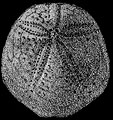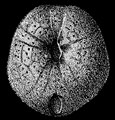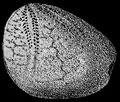The Echinoid Directory
Thomasaster Lambert, 1920, p. 138
[=Tomasia Lambert 1918, p. 32 (non Poche, 1900)]
| Diagnostic Features |
|
|---|---|
| Distribution | Cretaceous (Cenomanian) of Egypt |
| Name gender | masculine |
| Type | Archiacia araidahensis Gauthier, 1901, p. 46; by subsequent designation of Lambert 1920, p. 154. |
| Species Included |
|
| Classification and/or Status |
|
| Remarks |
|


